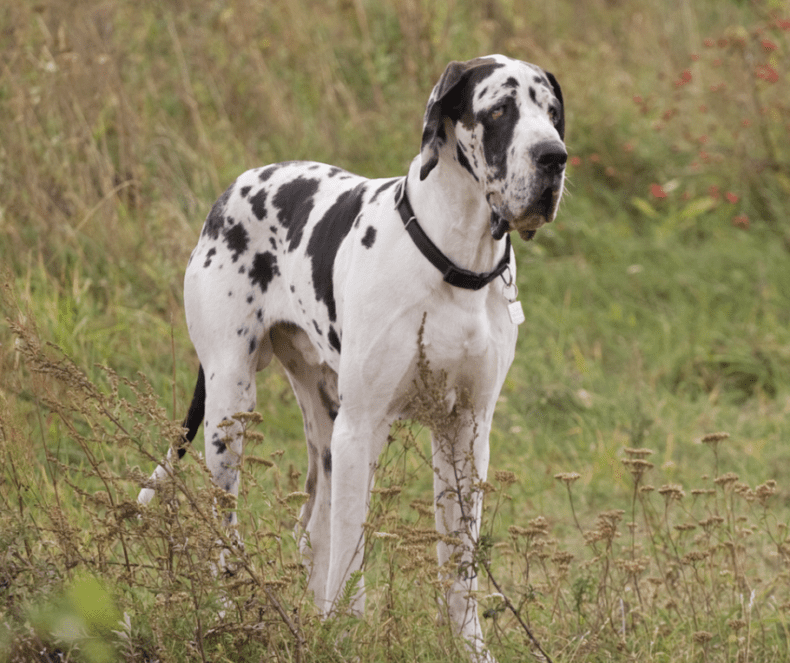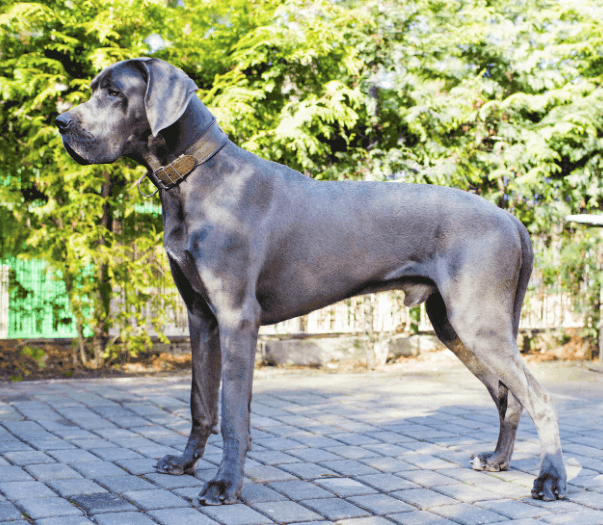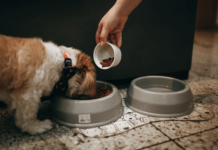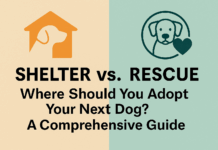Last Updated on April 26, 2023 by Dogs Vets
The Great Dane Bull Mastiff Mix (Bull Daniffs)
If you are looking for a large, loyal, and loving dog breed, you might want to consider the Great Dane Bull Mastiff mix. This hybrid, also known as the “Bull Daniff, is a cross between two giant breeds: the Great Dane and the Bullmastiff.
Both of these parent breeds have a long history of being working dogs and guardians, but they also have a gentle and affectionate side that makes them great family pets.
In this blog post, we will tell you everything you need to know about the Great Dane Bull Mastiff mix, including their appearance, temperament, health, grooming, training, and more. We will also give you some tips on how to find a reputable breeder or rescue for this rare mix.
What is a Great Dane Bull Mastiff Mix?
A Great Dane Bull Mastiff mix is a designer dog breed that comes from a purebred Great Dane mixed with a purebred Bullmastiff. The result of crossing two giant working breeds, the Great Dane Bull Mastiff mix is not your average hybrid.
These massive dogs can weigh over 150 pounds and stand up to 34 inches tall at the shoulder. They have a powerful and muscular build, but they also have a graceful and elegant appearance.
The Great Dane Bull Mastiff mix inherits traits from both of its parent breeds, but it is not possible to predict which ones they will get. Some may look more like a Great Dane, while others may look more like a Bullmastiff.
Some may have a short and smooth coat, while others may have a longer and wavier coat. Some may have floppy ears, while others may have erect ears. Some may have a brindle or fawn coloration, while others may have a black or white coloration.
The only way to know for sure what your Great Dane Bull Mastiff mix will look like is to meet them in person. However, you can get an idea of their general appearance by looking at their parent breeds.
History of the Bull Mastiff Mix
The Bull Mastiff Mix is not a purebred dog, but a hybrid that can have different origins depending on the other breed involved. However, we can trace the history of the Bullmastiff, which is one of its parent breeds.
The Bullmastiff was developed in England in the late 19th century by crossing Mastiffs and Bulldogs. The purpose was to create a large and powerful dog that could guard estates and hunt poachers.
The Bullmastiff was recognized by the American Kennel Club (AKC) in 1934 and is classified as a working dog.
The Great Dane
The Great Dane is one of the largest and tallest dog breeds in the world. They can weigh up to 200 pounds and stand up to 32 inches tall at the shoulder. They have a sleek and athletic body with long legs and a long tail.

They have a large and square head with expressive eyes and floppy ears (unless cropped). They have a short and smooth coat that comes in various colors and patterns, such as fawn, brindle, black, blue, harlequin, mantle, and merle.
The Great Dane is known as the “gentle giant” of the dog world because of their calm and friendly temperament. They are loyal and devoted to their owners and love to be around people. They are gentle and patient with children and other animals, but they can also be protective of their family if needed.
They are intelligent and eager to please, but they can also be stubborn and independent at times. They need early socialization and training to prevent them from becoming timid or aggressive.
The Great Dane has a moderate energy level and needs regular exercise to stay healthy and happy. They enjoy long walks, hikes, or play sessions with their owners.
However, they are not suitable for intense or strenuous activities that can put stress on their joints or heart. They are also not suitable for apartment living because of their size and need for space. They do best in homes with large yards where they can stretch their legs and relax.
The Great Dane has a low maintenance coat that only needs occasional brushing to remove loose hair and dirt. They shed moderately throughout the year and more heavily during seasonal changes.
They also need regular nail trimming, ear cleaning, teeth brushing, and bathing to keep them clean and healthy.
The Great Dane has an average lifespan of 8 to 10 years.
They are prone to some health issues that are common among large breeds, such as hip dysplasia, bloat (gastric torsion), heart problems (dilated cardiomyopathy), bone cancer (osteosarcoma), eye problems (glaucoma), thyroid problems (hypothyroidism), skin problems (acral lick dermatitis), and ear infections.
The Bullmastiff
If you are looking for a loyal and protective companion that can also deter intruders, you might want to consider the Bullmastiff. This dog breed is a cross between a Bulldog and a Mastiff, and it inherits the best traits of both.

The Bullmastiff is a large and powerful dog that can weigh up to 130 pounds and stand up to 27 inches tall at the shoulder.
They have a sturdy and muscular body with a broad chest and a short tail. Their coat is short and dense, and it comes in various colors such as brindle, fawn, or red.
The Bullmastiff has a large head with a wrinkled forehead and a black mask on its face.
The Bullmastiff is not only strong but also intelligent and loyal. They are devoted to their family and will protect them from any threat. They are also gentle and affectionate with their loved ones, especially children.
However, they can be wary of strangers and other dogs, so they need early socialization and training to prevent aggression or dominance issues.
The Bullmastiff is not a very active dog, but they still need regular exercise to keep them healthy and happy. They also need regular grooming to keep their coat clean and shiny.
The Bullmastiff is a great dog for people who want a faithful and fearless guardian that can also be a loving family member. They are suitable for living in large houses with fenced yards, but they can also adapt to apartment living if they get enough exercise.
They are not very vocal, but they will bark loudly if they sense danger or someone at the door. The Bullmastiff is a dog that will always be by your side and will never let you down.
The Great Dane Bull Mastiff Mix: What you need to know before getting one
The Great Dane Bull Mastiff Mix is a mix of two large breeds. It can be intimidating to think about getting one, but there are a few things you should know before getting one.
The Great Dane Bull Mastiff Mix is a mix of two large breeds and can be intimidating to think about getting one. But there are a few things you should know before getting one.
The Great Dane Bull Mastiff Mix is an intimidating dog that might not be the best choice for first-time dog owners or people with small living spaces.
They need plenty of space and regular exercise to remain happy and healthy, so they’re not the best choice for someone who lives in an apartment or doesn’t have time for walks every day.
What to Consider before Getting a Bullmastiff Mixed with Great Danes as Pets?
Bullmastiff mixed with Great Danes are not a common breed. However, they have a lot of qualities that make them great pets. They are loyal, protective, and obedient to their owners.
Before getting this dog as a pet, there are some factors that you should consider. One is the size of the dog since this is not an average-sized dog and it may be too big for your home or apartment.
The other factor is the energy level of the dog because this type of dog needs a lot of exercises to stay healthy and happy.
The third factor to consider before getting these breeds as pets is the cost because Bullmastiff mixed with Great Danes are not cheap breeds and they need more care than other breeds.
The Great Dane Bull Mastiff Mix Overview
| Height: | 25-34 inches |
| Weight: | 105-200 pounds |
| Lifespan: | 12-15 years |
| Colors: | Brindle, fawn, piebald, grey, chestnut, black, white, tricolored, patchwork |
| Suitable for: | Active families, households looking for a reliable watchdog, spacious homes, experience dog owners looking for a large dog |
| Temperament: | Confident, affectionate, protective, reserved, calm (as an adult) |
The Bull Daniffs are known for forming strong bonds with their families and being reserved with strangers. Which makes them ideal for families looking for a pet and a guardian for a dog.
While they may seem to look and appear too serious to many individuals, bull mastiffs also have a playful side that can make anyone laugh.
Let’s take a closer look at these massive Great dane bull mastiff hybrids:
How much does Great Dane bull Daniffs puppies cost?
The Purebred Bullmastiff puppies do vary in price, usually with a price ranging from $800 to $2,000. Because of the bloodlines and premium pedigree, some Bullmastiff puppies have sold for more than $6,000.
Purebred Great Dane puppies are about the same and usually fetch a price of $600 to $3,000. Factors such as companion or show ring lineage drastically change the price of Great Dane puppies.

Bull Daniffs are not purebred dogs, but their status as a designer dog breed has created a niche market for them. Depending on size and physical characteristics, you can expect to pay between $400 and $1,200 for a Bull Daniff puppy.
3 little things you need to know about Bull Daniffs
1. Bull Daniffs can weigh over 150 pounds
Bull Daniffs come from a large breed and a huge breed, so it should be noted that Bull Daniffs can easily weigh over 150 pounds on average.
If you are looking to purchase this hybrid, make sure you have room for these dogs. They may seem quite enough for apartments, but their size alone makes apartment living nearly impossible.
2. Bull Daniffs are surprisingly gentle
While some of the known medium and large dog breeds have trouble understanding their own strength, Bull Daniffs are actually quite gentle.
These hybrids, as well as their purebred parents, make excellent dogs for children of all ages due to their reserved nature.
3. Bull Daniffs can be stubborn.
Bull Daniffs are known for being loving and affectionate watchdogs, but they do have a certain stubbornness that can be difficult for first-time dog owners.
Bull Daniffs Temperament & Intelligence
These Crossbreeds dogs can be hard to guess when it comes to temperament and intelligence. Therefore, it’s hard to tell what to expect from your Bull Daniffs puppy.
Before we look at the Bull Mastiff personality and intelligence, let’s take a look at the Bullmastiff and Great Dane.
Great Danes are prized for their easygoing temperaments, often referred to as “gentle giants” for their gentle mannerisms. These huge canines are playful and affectionate, which is why they are popular as pets.
Great Danes have an instinctive need to guard the home, but they are not aggressive in their protective ways. They are smart and can recognize obedience fairly quickly, but Danes can become stubborn if pushed too far.
As with other dogs, early socialization is important to set appropriate boundaries with other people and animals.
Looking at both Great Danes and bullmastiff, it is safe to say that most bull Daniffs will be natural guardians and loving family pets.
These dogs need a confident leader to deal with possible stubbornness, but they are relatively calm and gentle.
Aside from testing their place in the household, they are loyal dogs that demand their families’ attention.
The Great Dane & Bull Mastiff Comparison Chart
| Height | 28 – 30 inches (F) |
27+ inches (F) |
| Weight | 110-140 pounds (F) |
120-170 pounds (F) |
| Temperament | ||
| Energy | ||
| Health | ||
| Grooming | ||
| Lifespan | ||
| Price |

Are bull Daniffs dogs good for families?
Yes. Despite their immense size and serious faces, the Bull Daniffs have a playful side that makes them ideal for families with children. Although they don’t require hours of exercise, Bull Mastiff enjoys watching from a distance to “supervise” children.
The only potential problem is that they may be overprotective of children, especially when strangers are around.
View this post on Instagram
Does the Great Dane bull mastiff Mix breed get along with other pets?
Yes. Great Danes and Mastiffs are not known to have strong prey drives, which is also true of most regular Bull Mastiff breeds.
As long as all pets are properly introduced, your new Bull Mastiff puppy will adjust to his new brothers and sisters fairly and quickly.
Things you should know if you own a Bull Daniff
Food and dietary requirements for the Great Dane bull Mastiff Mix
Bull Daniffs are prone to weight problems and obesity. Therefore, it is important to find a diet that is high in fiber. We recommend high-quality dry food designed for large breeds.
However, it is important to have enough fiber to aid in digestion. Before starting any new diet or dog food, consult with your veterinarian first.
View this post on Instagram
Exercise 🐕
Bullmastiffs and Great Danes are both known for their lower exercise needs.
Bull Daniffs are large dogs that need adequate exercise to prevent weight gain and other health problems, but they are not as energetic as other large breeds.
They need at least two long walks a day and some time to walk around on a leash. It is important not to over-train Bull Daniff puppies as their bones are still growing and developing.
Since Great Danes are good at tracking, your Bull Daniff may inherit this ability. Tracking can be a fun and entertaining exercise for your new dog, especially for Bull Daniffs who need a confidence boost.
Consider setting up a dog-friendly scavenger hunt, which is great for exercise and sharpens your dog’s mind.
Training 🎾
Bull Daniffs thrive with a confident leader and positive food-based training, especially Daniffs that have more Bullmastiff qualities.
These dogs are sensitive and will resist commands if they feel they are being teased. Therefore, it is important to be gentle and consistent with any training method.
Stubbornness can be a real problem if left unchecked, but patience and consistent training are the keys to successfully training these large dogs.
Since both breeds absolutely need early socialization and consistent training, consider a group-based puppy obedience class. This will not only teach you and your dog the basics, but will also give your new puppy the opportunity to meet other dogs.
If you continue to struggle with your Bull Daniff, a professional dog trainer can help you overcome your dog’s training or behavior issues.
Please make sure of these requirements: Therefore, it is important to be gentle and consistent with any training method. Seeking the help of experienced dog training professionals would be the right way to go about the training process.
Grooming ✂️
Bull Daniffs have short coats that shed moderately. So a good brushing out once a week can help reduce shedding.
We recommend a curry comb to remove dirt and trapped fur as well as massage the skin and coat. Otherwise, their coats are low maintenance and combing does not take hours.
Both Bullmastiffs and Daniffs are prone to sensitive skin, so it’s important not to bathe them too often. If your Bull Daniff appears to be balding due to excessive shedding, contact your veterinarian and watch for other spots.
Health and Conditions 🏥
It’s impossible to know what your puppy will be dealing with later in life, even with purebred dogs.
One way to know what you may be dealing with is to research your puppy’s parents and their health issues, as well as the lineage to determine what other dogs of the same bloodline have suffered from.
Another way to prepare is to investigate common health problems of both Great Danes and Bullmastiffs. However, this does not guarantee that your puppy will inherit any of these problems.
Common Health problems of Bullmastiffs:
- Bloat
- Obesity
- Cancer
- Hip Dysplasia
- Elbow Dysplasia
- Subaortic Stenosis
- Chronic dry skin
- Hypothyroidism
- Entropion
There are some conditions that both Great Danes and Bullmastiffs suffer from. Therefore, it is not surprising that your Bull Daniff might do the same.
Conditions such as hip dysplasia and bloat are common in both breeds, especially due to their size.
Other conditions that your Bull Daniff may inherit are the various skin and eye problems of both breeds, as well as hypothyroidism. Although most of these conditions are moderately severe, it is not possible to determine whether or not your puppy has inherited them.
Male Vs Female
Choosing between males and females should be a personal decision, but it is best to keep in mind that male Bullmastiffs and male Great Danes have a considerable difference from females of both breeds.
Aside from a large size difference, choosing a male or female Bull Daniff is a personal matter that should be discussed with everyone involved.
Bull Mastiffs are large and powerful dogs that were originally bred for guarding and hunting. They are loyal, courageous and affectionate to their owners, but can be wary of strangers and other animals.
Bull Mastiffs come in two genders: male and female.
There are some differences between them that you should know if you are considering getting one as a pet or a companion.
One of the most obvious differences is the size. Male Bull Mastiffs are typically larger and heavier than females. They can weigh up to 130 pounds and stand up to 27 inches at the shoulder. Females are usually around 100 pounds and 24 inches tall.
The size difference can affect the temperament and energy level of the dog. Males tend to be more dominant and assertive, while females are more submissive and gentle.
Males may also require more exercise and training to keep them from becoming bored or destructive.
Another difference is the appearance. Male Bull Mastiffs have a more pronounced head and muzzle, with a wider skull and a deeper stop. They also have a thicker neck and chest, giving them a more muscular look.
Females have a more refined head and muzzle, with a narrower skull and a less prominent stop. They also have a slimmer neck and chest, giving them a more elegant look.
Both genders have short, dense coats that come in various colors, such as fawn, red or brindle.
A third difference is the health. Male Bull Mastiffs are more prone to certain health issues than females, such as hip dysplasia, elbow dysplasia, bloat and cancer.
These conditions can affect the mobility and lifespan of the dog. Females are less likely to develop these problems, but they may have other issues related to their reproductive system, such as pyometra, mammary tumors or false pregnancy.
These conditions can affect the fertility and well-being of the dog. Both genders should be spayed or neutered to prevent unwanted pregnancies and reduce the risk of some diseases.
These are some of the main differences between a male and a female Bull Mastiff. Of course, each dog is an individual and may not fit into these generalizations.
The best way to choose a Bull Mastiff is to meet them in person and see which one matches your personality and lifestyle. Bull Mastiffs are wonderful dogs that can make great companions for the right owners.
How to find a reputable breeder or rescue for Great Dane Bull Mastiff Mix
If you are looking for a Great Dane Bull Mastiff Mix, also known as a Daniff, you might be wondering how to find a reputable breeder or rescue for this large and loyal breed. Here are some tips to help you in your search.
First, you should do some research on the breed and its characteristics.
A Daniff is a cross between a Great Dane and a Bull Mastiff, two giant breeds that have different temperaments and needs.
A Daniff can weigh up to 200 pounds and stand up to 34 inches at the shoulder.
They are usually friendly, gentle, and protective of their family, but they can also be stubborn, independent, and prone to health issues such as hip dysplasia, bloat, and heart problems. They need a lot of space, exercise, and socialization to thrive.
Second, you should decide whether you want to get a Daniff from a breeder or a rescue. There are pros and cons to both options.
A breeder can provide you with more information about the puppy’s parents, health history, and pedigree.
However, finding a reputable breeder can be challenging, as there are many irresponsible or unethical breeders who produce Daniffs for profit without regard for their welfare.
A rescue can offer you a chance to adopt a Daniff that needs a loving home and may have already been spayed/neutered, vaccinated, and trained. However, finding a rescue that specializes in Daniffs can be difficult, as they are not a very common breed.
Third, you should look for signs of quality and trustworthiness in the breeder or rescue you choose. A reputable breeder should:
- Have a clean and spacious facility where the dogs are well cared for.
- Show you the puppy’s parents and their health certificates.
- Provide you with a written contract that includes a health guarantee and a return policy.
- Ask you questions about your lifestyle, experience, and expectations.
- Be willing to keep in touch with you and offer support after you take the puppy home.
A reputable rescue should:
- Have a thorough screening process that includes an application, interview, home visit, and reference check.
- Provide you with the dog’s medical records and behavior assessment.
- Charge a reasonable adoption fee that covers the cost of veterinary care and other expenses.
- Ask you to sign an adoption contract that outlines your responsibilities and rights as an adopter.
- Be willing to take the dog back if the adoption does not work out
By following these tips, you can find a reputable breeder or rescue for a Great Dane Bull Mastiff Mix and enjoy the companionship of this magnificent breed.
Final Thoughts:
Bull Daniffs may be large dogs, but they are loving and affectionate protectors of their families. These massive hybrids enjoy consistent attention and affection, making them best suited for families who are home frequently.
It’s important to remember that at 150 pounds, these dogs can easily top the scale, so they need ample room to stretch their legs.
While their size can be a major dealbreaker for some, they don’t have as many training requirements as other breeds.
If you are looking for a calm, reserved guard dog that is also gentle and safe around children, the Bull Daniff will not disappoint.
FAQ’S
How big can a Great Dane Mastiff Mix get?
Great Danes and English Mastiffs are both huge breeds, so you can expect to have a very large adult dog.
Most Danifs are between 27 and 33 inches tall, and their weight ranges from 115 pounds to about 190 pounds, depending on the sex of the puppy and the size of the parents.
Do Bullmastiffs bark a lot?
Bullmastiffs are one of those dogs. They are very watchful, alert but do not bark too much. The dogs were originally developed in the 19th century to guard estates. They are one of the largest of the non-barking breeds and weigh about 50 kg (110 lbs), sometimes more.
How much does a Daniff cost?
You can expect to pay between $500 and $1,000 for a Danif. Even from high end breeders, the price of a Danif will rarely exceed $1,000.
Are Bullmastiffs dangerous dogs?
They are descended from wolves and were bred by humans, resulting in them being one of the most loyal and dangerous animals.
Are Great Danes Easy to Train?
Great Danes are considered gentle giants. They are moderately playful, affectionate, and good with children. Great Danes are considered to be easy to train, but some Great Dane enthusiasts say that individuals can be stubborn learners.
How long does a Daniff live?
The average lifespan of a Danif is between 8 to 12 years.
Which dog is bigger? Great Dane or Wolf?
Thus, a “The Great Dane” outweighs almost all wolves and can weigh four times as much as a small wolf. A large gray wolf may reach 3 feet in body height and 5.2 feet in length. A large Great Dane may reach about 2.8 feet tall and 3 feet long. A large gray wolf is larger than a large Dane.
Which dog is bigger than a Great Dane?
Wolfhounds win by inches as the tallest dog breeds in the world. The Irish Wolfhound is the tallest of all dogs, even the Great Dane. According to the breed standard, the minimum height should be 32 inches for males and 30 inches for females. That is a minimum.
Does the Bullmastiff attack intruders?
The Bullmastiff is best known for its unique and large appearance. … Unlike Great Danes, Bullmastiffs will not only bark, but will attack intruders if necessary.
Having said that, they make great additions to the family, especially when brought home as puppies and raised with the same family.
Do Bullmastiffs bite?
Bullmastiffs are one of the dogs used to discourage intruders, but they are not well known for their bites. Bullies will bark, growl, and give ground long before they bite. When Bullmastiffs resort to biting, they have a very powerful and destructive bite.
Are Great Danes of high maintenance?
Great Danes are known to be gentle giants, they are eager to please, and loves people. When compared to other large dog breeds, these dogs are fairly low maintenance. … You also need to pay attention to the dog’s exercise needs, proper diet, toys, a big bed, and regular visits to the vet.
Can I leave my Great Dane alone?
For the most part, Great Danes are couch potatoes and require short periods of activity, a few short walks a day, and some periods of time off-leash to run and play in the yard.
Some Danes, however, can become destructive if left unattended.
Bullmastiffs are very easy to train
Bullmastiffs are powerful dogs, but they are sensitive. Given the breed’s strength and tendency to be independent, early socialization and training are essential.
How much does a baby Great Dane cost?
How much do Great Danes cost? Adoption costs vary, but young adults are $325 and puppies are $375. If you buy a Dane from a breeder, expect to pay between $600 and $3000, depending on whether it is a companion or show dog.
Can Daniff swim?
Danifs don’t always go to the water on their own, but if they’ve been trained to enjoy a good swim, this exercise is great for oversized breeds! Both young and senior Danifs have fragile joints, so swimming can be an excellent activity with a low risk of injury.
Why are Bullmastiffs banned?
Nonetheless, the American Bulldog is banned in many cities because many people stereotype the breed as dangerous. However, as many dogs vets have explained, these labels are usually wrong. Some irresponsible owners ignore their dogs or teach them aggressive behavior.
Reference: Doggiedesigner.com

















